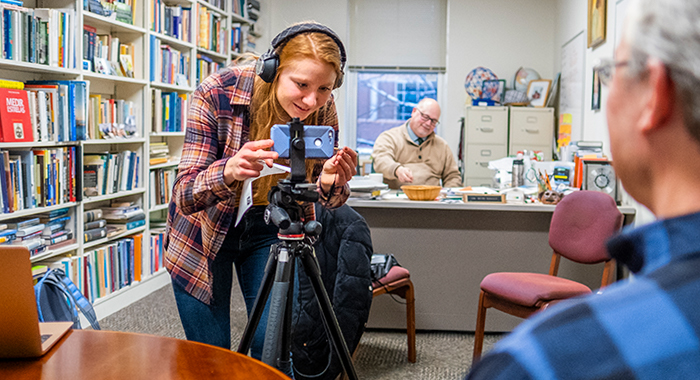Student Team Supports Full-Spectrum Learning Initiative
Cassie Nooyen ’22 is learning firsthand what it means to work side-by-side – if, for now, remotely – as a partner in shaping her own learning and in broadening opportunities for others to come.
She is part of a five-student team hired to collaborate on St. Norbert’s Full-Spectrum Learning (FSL) program. Full-Spectrum has been in the works for seven to eight years but has really picked up steam in the past two years. The idea is to track the many ways St. Norbert professors teach – from traditional lectures in front of the classroom to complete online collaboration with students – as a first step to expanding offerings to students.
“When we first began researching what we first called ‘digital learning,’ we focused on teachers and learning,” says Reid Riggle, co-chair of teacher education.
“While that was good, we discovered we had to do this with students as co-leaders in the project. They needed to be partners as we moved forward.”
Nooyen was one of the first to come aboard, helping with the technical aspects of designing a website and grid. Other FSL fellows this year are Lexi Ford ’22, Britney Breckheimer ’23, Ruthie Tucker ’22 and Sophia Sorenson ’23.
“It turned out to be a lot more than working on technology,” Nooyen says. As she learned more about Full-Spectrum, Nooyen became a student advocate for the idea, attending and presenting at two conferences in summer.
“That greatly helped my confidence in speaking in front of other people and even general conversations with professors,” Nooyen says. “I could have never imagined how much it would have helped me with technical skills but also the ability to present in front of large groups of people and the connections with professors around campus.”
Diversifying structures
Teachers may be good at traditional ways of teaching in familiar structures, but in a contemporary world they need to diversify, Riggle says. But pushing professors to work the same way isn’t the answer, he says. Rather, students need a variety of teaching styles and approaches. Math classes might work best as traditional lecture-based classes, for example, while English lit could work well as a mix of lectures and online student-and-teacher collaboration. At the other end, some classes could be entirely online to the point where teachers and students are working together to create a digital textbook to be used by future classes.
Under this umbrella, Knight Domains is an initiative to help students build and curate their own online footprint and to tell the story of their own learning. Some courses are being built around these sites to help students build a portfolio that represents who they are when they graduate and look for jobs.
“We are one of the few schools across the nation that allows students to do this,” Nooyen says. “I wasn’t expecting to be one of the role models for others across the country and the world. Presenting to a group of people who were mostly experts in the field was very intimidating, but the response was nothing but kind, and I loved the experience of being one of the few students at the conference. This experience has also helped my confidence in speaking with professors.”
Nooyen’s experience is what Riggle hopes for.
“I told (students) that in this space I think of them as colleagues,” Riggle says. “It’s not me saying, ‘This is the way I want it.’ ”
Giving up control can be a challenge for instructors, he acknowledged, but Full-Spectrum shows some students will learn best by independent or side-by-side learning with professors.
Finding opportunities
Although the Full-Spectrum team is not earning credit or in a traditional classroom, they are modeling the idea behind the project.
“They really have gotten the opportunity for this deep, deep learning,” Riggle says. “They are coming at this from the lens of the teacher, and they get that.”
Nooyen says that’s important for college students.
“Right now we’re more professor-based, but we want to get students on the grid so they can see what’s available around campus,” she says. “As a math major, my classes are more lecture-based, so it’s interesting to see what other professors are doing.”
“No two students learn identically,” she continued. “We want students to see the opportunities that are out there.”
Sorenson does graphic design for the program. “There’s all different ways of learning,” she says. She hopes that her work, showing where classes are on the spectrum, will encourage prospective students looking at liberal arts colleges to keep St. Norbert high on the list of schools they’re considering.
Breckheimer’s work for the program includes creating an informational postcard and making sure the program is known on social media.
“This is really a forward progressive look at this type of teaching,” she says. “It’s not just thinking that your way is the best way. When I go into my teaching career, the students will learn differently. The grid helps you think about that.”
The initiative is special for a college of St. Norbert’s size, she says. “It’s really cool to see all the ways teachers teach and students learn. This is something every school needs to think about.”
March 23, 2020












